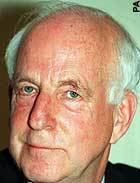Nationality British Occupation Business manager | Name Ernest Saunders | |
 | ||
Full Name Ernest Walter Schleyer Criminal charge Conspiracy to contravene section 13(1)(a)(i) of the Prevention of Fraud (Investments) Act 1958, false accounting and theft Criminal penalty Five years' imprisonment Criminal status Released after 10 months Similar People Peter Brabeck‑Letmathe, James Walter Thompson, Henri Nestle | ||
Gerald ronson on ernest saunders altzheimer s
Ernest Walter Saunders (born 21 October 1935) is a British former business manager, best known as one of the "Guinness Four", a group of businessmen who attempted fraudulently to manipulate the share price of the Guinness company. He was sentenced to five years' imprisonment, but released after 10 months as he was believed to be suffering from Alzheimer's disease, which is incurable. He subsequently made a full recovery.
Contents
- Gerald ronson on ernest saunders altzheimer s
- Personal life
- Professional life
- Sentence and appeal
- Later life
- References
Personal life
He was born Ernest Walter Schleyer in Austria and moved to the United Kingdom in 1938 when his parents emigrated to escape Nazi rule. He was educated at Emmanuel College, Cambridge. He married Carole Ann Stephing in 1963, and has two sons and one daughter.
Professional life
He had a career in management with Beecham, Great Universal Stores and Nestlé before becoming chief executive of Guinness plc (now a part of Diageo plc) in 1981, remaining in the position until 1986. He was renowned for his ruthless cost-cutting efficiency, earning from his employees the sobriquet 'Deadly Ernest'.
Under his charge, early in 1986, Guinness plc launched a friendly takeover bid for Edinburgh-based United Distillers plc, which was being stalked by a hostile bidder. This was effected by quietly boosting the Guinness share price. Subsequent to the bid, which resulted in success for Guinness, Saunders was charged (along with Jack Lyons, Anthony Parnes and Gerald Ronson) and convicted on 27 August 1990 of counts of conspiracy to contravene section 13(1)(a)(i) of the Prevention of Fraud (Investments) Act 1958, false accounting and theft, in relation to dishonest conduct in a share support operation (see Guinness share-trading fraud). A series of appeals was finally dismissed in December 2002, although a ruling by the European Court of Human Rights in Saunders v. the United Kingdom declared that the defendants were denied a fair trial by being compelled to provide potentially self-incriminatory information to Department of Trade and Industry (DTI) inspectors which was then used as primary evidence against them. This breached their right to silence.
While there was no suggestion that Saunders himself sought to or actually did profit from these offences in an immediate or direct manner, the allegation was that they were committed to increase the likelihood of their company's takeover bid succeeding. His board of directors at Guinness plc was not informed of, and had not sanctioned, his arrangements, which included indemnities for unknowable amounts. He had passed $100 million to the American Ivan Boesky to invest shortly before Boesky's prosecution and imprisonment for insider trading, and following that investigation Saunders' plans were revealed to the DTI in Britain.
A DTI report described him as a man who did "unjustifiable favours for friends and himself".
Sentence and appeal
Saunders appealed against his prison sentence of five years and three expert witnesses appeared at the Appeal Court. A consultant neurologist acting for the Crown, Dr Perkins, insisted that Saunders was suffering from depression rather than Alzheimer's disease. One of the other expert witnesses, another neurologist, used brain scans and other evidence to indicate that Saunders brain was abnormally small for a man of his age, an observation which he said was consistent with a brain disease diagnosis.
On 16 May 1991, the sentence was reduced to two and a half years. Lord Justice Neill said that he was satisfied that Saunders was suffering from pre-senile dementia associated with Alzheimer's disease, which is incurable. The decision was based on evidence from Dr Patrick Gallwey, a forensic pathologist, that Saunders was unable to recite three numbers backwards, was unable to use a door and his assertion that Gerald Ford rather than George Bush was the current President of the United States.
Because of his apparent illness, Saunders was released from Ford Open Prison on 28 June 1991 having served only ten months of his sentence. (He would normally have been expected to have served 15 months of the 30-month sentence). After his release, he recovered from the symptoms which had led to the diagnosis. Saunders himself claimed in 1994 that he was never diagnosed with Alzheimer's, When asked by The Independent in 1996, Dr Gallwey commented: "In the early stages of Alzheimer's or pre-senile dementia, it can be very difficult to make a diagnosis, so we did not make one; we expressed worries about it." It has been suggested he was in reality suffering from memory loss caused by stress.
Later life
Since then, Saunders has worked as a business consultant, including advising mobile phone retailer Carphone Warehouse from its early days until prior to its flotation. Charles Dunstone, the Chief Executive of Carphone Warehouse, said: "We were young guys who didn’t know what we were doing. He made us think about the questions we ought to ask or the information we ought to look at."
He was later appointed chairman of the executive committee of a US-based multinational petrol credit-card company, Harpur-Gelco.
Saunders also acted as a consultant to Seed International Ltd, a company based in the Cayman Islands. Seed offered investments in a variety of fields including wine, property, oil and gas exploration through Ocean International Marketing, their sales subsidiary with offices in Rotterdam.
